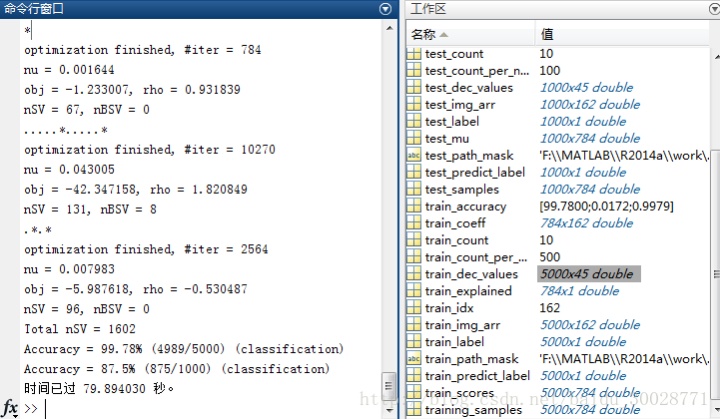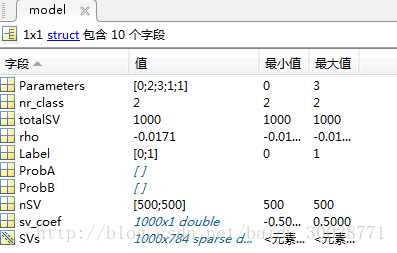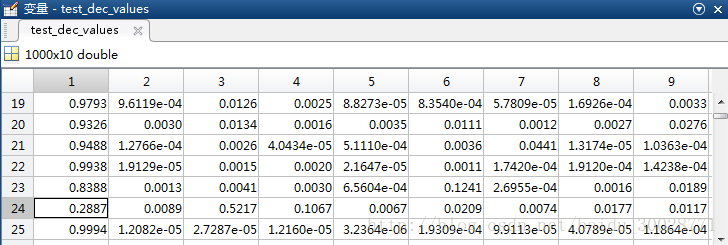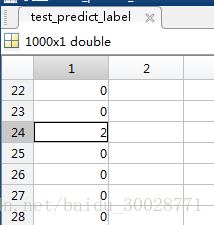本文采用pca算法提取图像特征,然后再用svm进行分类。
主要分为两步:
1、pca特征提取
pca主成份分析,主要用来进行人脸识别,具体原理介绍可以参考这篇博客http://blog.codinglabs.org/articles/pca-tutorial.html ,提取pca特征主要有以下几个步骤:
(1)将图像归一化到固定大小n*n,然后展开为1*n^2的一维向量,假设有m个样本,则最终形成一个m*n^2的数组,每一行代表一个样本,本文所用的图像大小为28*28,样本类别为10,每个类别训练图为500张,则每一张图展开后就是一个1*756的一维向量,最终形成一个5000*756的数组dm;
(2)求每一个列向量的均值avg,其大小为1*n^2;
(3)差值a=dm-avg;
(4)协方差b=a*a’;
(5)求协方差矩阵b的特征值和特征向量,取前k个最大特征值及对应的特征向量T;
(6)令c=a’*T,c的大小为n^2*k,向量c则为原始图像到投影空间的投影向量;
(7)投影向量p=dm*c为样本的特征向量,其大小为m*k,即将一个n*n大小的图像映射为一个1*k的向量,每一行代表一个样本;
(8)将求得的投影向量p送到svm分类器中进行训练。
识别的时候,只需要将待识别的图像d(1*n^2)先减去均值avg,再与投影向量c相乘,即将原始图像d投影到其主成份分量所在的投影空间中,然后用训练好的svm模型进行识别。 matlab自带pca的函数,可以直接调用,当然也可以自己实现pca,过程也比较简单。
2、svm分类
libsvm中实现多分类采用的是one-versus-one法,参照http://blog.csdn.net/liulina603/article/details/8498759 。
整个流程的代码如下:
clear;clc;
% 训练样本数量10*500
train_count=10;
train_count_per_num=500;
% 能量
energy=90;
train_path_mask='F:MATLABR2014aworklibsvm-3.11datashouxiepca_svmtrain%01d%01d.bmp';
training_samples=[];
train_label=[];%训练标签
% img_size=10;% 归一化图像大小
% 训练,自带的pca函数
tic
for i=0:train_count-1
for j=1:train_count_per_num
img=imread(sprintf(train_path_mask,i,j));
% img=imresize(img,[img_size img_size]); % 归一化
if ndims(img)==3
img=rgb2gray(img);
end
img=im2bw(img,5/255);
training_samples=[training_samples;img(:)'];
end
train_label(i*train_count_per_num+1:(i+1)*train_count_per_num)=ones(1,train_count_per_num)*i;
end
training_samples=double(training_samples);%一定要转double
train_label=train_label'; %训练的标签
% mu=mean(training_samples); %训练集中的平均值
[train_coeff,train_scores,~,~,train_explained,mu]=pca(training_samples); %pca
train_idx=find(cumsum(train_explained)>energy,1); %idx为前k个特征向量,explained特征值
train_coeff=train_coeff(:,1:train_idx); %投影向量
train_img_arr=train_scores(:,1:train_idx); %特征向量,训练的样本集
%svm训练
model = svmtrain(train_label, train_img_arr, '-s 0 -c 1.5 -t 0 -g 3');
save('shouxie_model','model'); %保存svm模型
xlswrite('train_coeff.xlsx',train_coeff); %保存特征向量
xlswrite('mu.xlsx',mu); %保存样本平均值,单样本进行测试的时候会用到
%使用训练集数据进行测试
[train_predict_label, train_accuracy, train_dec_values] =svmpredict(train_label, train_img_arr, model); % test the trainingdata
%测试
test_path_mask='F:MATLABR2014aworklibsvm-3.11datashouxiepca_svmtest%01d%01d.bmp';
test_count=10;
test_count_per_num=100;
test_samples=[];
test_label=[];
for i=0:test_count-1
for j=1:test_count_per_num
img=imread(sprintf(test_path_mask,i,j));
% img=imresize(img,[img_size img_size]); % 归一化
if ndims(img)==3
img=rgb2gray(img);
end
img=im2bw(img,5/255);
test_samples=[test_samples;img(:)'];
end
test_label(i*test_count_per_num+1:(i+1)*test_count_per_num)=ones(1,test_count_per_num)*i;
end
test_samples=double(test_samples);
test_label=test_label';
% test_img_arr=test_samples(:)-mu;
test_mu=repmat(mu,1000,1);
test_img_arr=test_samples-test_mu;
test_img_arr=test_img_arr*train_coeff; %测试集数据投影到投影向量上
%svm测试
[test_predict_label, test_accuracy, test_dec_values] =svmpredict(test_label, test_img_arr, model);
toc
% test_img1=imread('F:MATLABR2014aworklibsvm-3.11datashouxiepca_svmtest010.bmp');
% % test_img1=imresize(test_img1,[img_size img_size]);
% test_img1=rgb2gray(test_img1);
% test_img1=im2bw(test_img1,5/255);
% test_img1=double(test_img1);
% test_img_arr1=test_img1(:)'-mu;
% test_img_arr=test_img_arr1*train_coeff;
% [predict_label, accuracy, dec_values] =svmpredict(1, test_img_arr, model); 
用训练样本进行测试的时候,Accuracy = 99.78% (4989/5000) ,用新的测试集时, Accuracy = 87.5% (875/1000),比直接使用原始图进行训练高多了,当然,其精度还可以进一步提升。改变-s -c -t -g 等参数进行训练时,可能会出现过拟合、欠拟合等情况,需要多次尝试确定其合适的参数值大小。参数调优可以参照这篇博客http://blog.csdn.net/chunxiao2008/article/details/50448154 。
3、参数讲解
在使用libsvm工具箱的时候,主要用到了svmtrain、svmpredict两个函数,现在介绍下其中的几个重要的参数。
使用svmtrain后会得到一个model,参数如下:

model.Parameters参数意义从上到下依次为,在svmtrain函数可以通过字符串进行设置:
-s svm类型:SVM设置类型(默认0)
-t 核函数类型:核函数设置类型(默认2)
-d degree:核函数中的degree设置(针对多项式核函数)(默认3)
-g r(gama):核函数中的gamma函数设置(针对多项式/rbf/sigmoid核函数) (默认类别数目的倒数)
-r coef0:核函数中的coef0设置(针对多项式/sigmoid核函数)((默认0)。
具体解释可以在readme文档中查看,
options:
-s svm_type : set type of SVM (default 0)
0 – C-SVC
1 – nu-SVC
2 – one-class SVM
3 – epsilon-SVR
4 – nu-SVR
-t kernel_type : set type of kernel function (default 2)
0 – linear: u’*v
1 – polynomial: (gamma*u’*v + coef0)^degree
2 – radial basis function: exp(-gamma*|u-v|^2)
3 – sigmoid: tanh(gamma*u’*v + coef0)
4 – precomputed kernel (kernel values in training_set_file)
-d degree : set degree in kernel function (default 3)–核函数中的degree设置(针对多项式核函数)(默认3)
-g gamma : set gamma in kernel function (default 1/num_features)–核函数中的gamma函数设置(针对多项式/rbf/sigmoid核函数)(默认1/ k)
-r coef0 : set coef0 in kernel function (default 0)–核函数中的coef0设置(针对多项式/sigmoid核函数)((默认0)
-c cost : set the parameter C of C-SVC, epsilon-SVR, and nu-SVR (default 1)–设置C-SVC,e -SVR和v-SVR的参数(损失函数)(默认1)
-n nu : set the parameter nu of nu-SVC, one-class SVM, and nu-SVR (default 0.5)–设置v-SVC,一类SVM和v- SVR的参数(默认0.5)
-p epsilon : set the epsilon in loss function of epsilon-SVR (default 0.1)–设置e -SVR 中损失函数p的值(默认0.1)
-m cachesize : set cache memory size in MB (default 100)–设置cache内存大小,以MB为单位(默认100)
-e epsilon : set tolerance of termination criterion (default 0.001)–设置允许的终止判据(默认0.001)
-h shrinking : whether to use the shrinking heuristics, 0 or 1 (default 1)–是否使用启发式,0或1(默认1)
-b probability_estimates : whether to train a SVC or SVR model for probability estimates, 0 or 1 (default 0)
-wi weight : set the parameter C of class i to weight*C, for C-SVC (default 1)–设置第几类的参数C为weight*C(C-SVC中的C)(默认1)
-v n: n-fold cross validation mode–n-fold交互检验模式,n为fold的个数,必须大于等于2
-q : quiet mode (no outputs)
model.nr_class表示有多少类别,这里是二分类;
model.Label表示标签,这里是0、1;
model.totalSV代表总共的支持向量的数目;
model.nSV表示每类样本的支持向量的数目,与model.label相对应的;
rho偏移量-b;
SVM模型有两个非常重要的参数C与gamma。其中 C是惩罚系数,即对误差的宽容度。c越高,说明越不能容忍出现误差,容易过拟合。C越小,容易欠拟合。C过大或过小,泛化能力变差。
gamma是选择RBF函数作为kernel后,该函数自带的一个参数。隐含地决定了数据映射到新的特征空间后的分布,gamma越大,支持向量越少,gamma值越小,支持向量越多。支持向量的个数影响训练与预测的速度。svmpredict函数用法:
[predict_label, accuracy, dec_values] =svmpredict(test_label, test_img_arr, model);
返回三个参数,predict_label为预测的类别,
accuracy有三个值,分别是分类准率(分类问题中用到的参数指标),平均平方误差(MSE (mean squared error)) [回归问题中用到的参数指标],平方相关系数(r2 (squared correlation coefficient))[回归问题中用到的参数指标];
dec_values,一个矩阵包含决策的值或者概率估计。对于n个预测样本、k类的问题,如果指定“-b 1”参数,则n x k的矩阵,每一行表示这个样本分别属于每一个类别的概率;如果没有指定“-b 1”参数,则为n x k*(k-1)/2的矩阵,每一行表示k(k-1)/2个二分类SVM的预测结果;
test_label为测试样本标签,如果未知,可以随意给定,但必须和test_img_arr维数对应,如果已知,则在计算accuracy的时候,会将predict_label与test_label进行比较求准确度(对于多个测试样本)。
在svmtrain的时候设置’-b 1’,svmpredict的时候设置’-b 1’,可以看到dec_values的值为每一个样本属于每一个类别的概率,我们看下第24个测试样本,正确分类应该是数字0,即应该分到第一类,其dec_values值最大的是0.5217属于第三类,即数字2,与predict_label相吻合。


参考:
http://blog.sina.com.cn/s/blog_6646924501018fqc.html
http://blog.csdn.net/bryan__/article/details/51506801




















 1万+
1万+

 被折叠的 条评论
为什么被折叠?
被折叠的 条评论
为什么被折叠?








